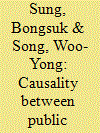| Srl | Item |
| 1 |
ID:
119788


|
|
|
|
|
| Publication |
2013.
|
| Summary/Abstract |
This article investigates the causal relationship between public policies and exports of renewable energy technologies using panel data from 18 countries for the period 1991-2007. A number of panel unit root and cointegration tests are applied. Time series data on public policies and exports are integrated and cointegrated. The dynamic OLS results indicate that in the long run, a 1% increase in government R&D expenditures (RAD) increases exports (EX) by 0.819%. EX and RAD variables respond to deviations from the long-run equilibrium in the previous period. Additionally, the Blundell-Bond system generalized methods of moments (GMM) is employed to conduct a panel causality test in a vector error-correction mechanism (VECM) setting. Evidence of a bidirectional and short-run, and strong causal relationship between EX and the contribution of renewable energy to the total energy supply (CRES) is uncovered. CRES has a negative effect on EX, whereas EX has a positive effect on CRES. We suggest some policy implications based on the results of this study.
|
|
|
|
|
|
|
|
|
|
|
|
|
|
|
|
| 2 |
ID:
167021


|
|
|
|
|
| Summary/Abstract |
This study investigates how government policies affect firm-level innovation. To empirically test this relationship, we use panel data for the Korean renewable energy technology firms. Taking into account the results of various panel framework tests and sample size, we establish a panel vector autoregressive model in the first difference, and use a bias-corrected least squares dummy variable estimator to test complex dynamic relationships between public subsidies, firm heterogeneities (size, age, and slack), industry dynamic competition, and innovation. Based on the estimations, we find that there is a positive bidirectional causal relationship between firms’ innovation and each of the following: research and development (R&D) subsidy, available organizational slack, and industry dynamic competition. Non-R&D subsidy, firm size, and age do not have significant direct effects on firm-level innovation. However, non-R&D subsidy is involved in the relationship between R&D subsidy and firms’ innovation. We discuss some implications based on the findings of this study.
|
|
|
|
|
|
|
|
|
|
|
|
|
|
|
|